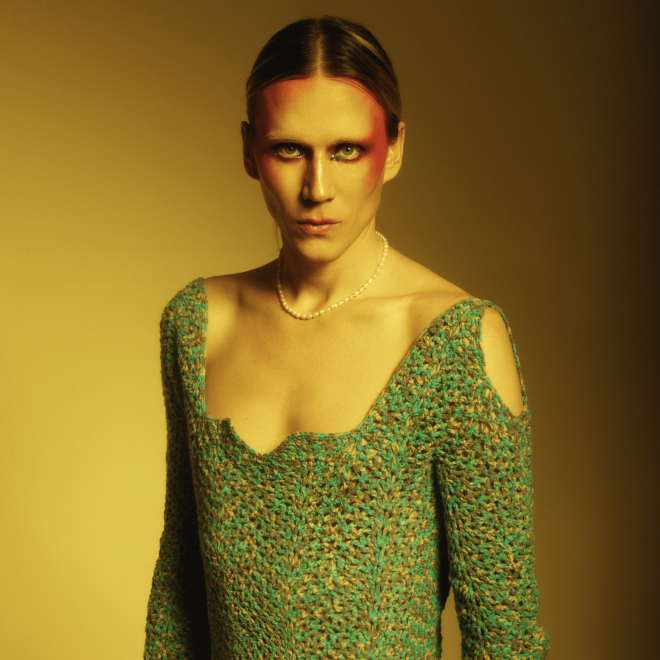S.A.M
Silence and rebellion

Known for their dynamic live performances, S.A.M. has established themselves as a force in the scene, where they seamlessly blend ambient soundscapes with pulsating rhythms. Their upcoming live performance in 2025 promises to be a transformative experience, inviting audiences to not only dance but also reflect on the deeper connections between music and emotion. As a firm believer in the partnership between music and silence, S.A.M. crafts experiences that resonate on a personal level, drawing listeners into a world where every beat carries significance.
At the heart of S.A.M.’s artistry lies a commitment to inclusivity and self-expression, making their music a vehicle for rebellion against societal norms. Recognizing the club scene as a historically rich space for marginalized voices, S.A.M. aims to honor this tradition through their work, creating environments where everyone feels welcomed and celebrated. By fostering a collective experience that transcends individual identities, they continue to reshape the narrative of what it means to connect through music and more importantly, through silence
“This is perhaps the most important dynamic of my life from the way I try to live in tune with myself and ensure what I do is honest, to the way I make music by only adding sounds I feel are both worthy and serve a purpose to the silence surrounding it. Groove isn’t maxing out the syncopation effectively shoving sounds into every space. The space gives strength to the sounds. Without the quiet parts it would just all become noisy and annoying. Silence is the source of energy. I have always needed my space. Since I was a kid I would spend a lot of time in solitude, just being outside or in my room. I don’t remember ever feeling bored. I would meditate in the forest in my teens and write poetry here and there as well as play and record music. I think this solitude has always stayed with me as a very important inner sanctuary”.
“I can always visit this inner room wherever I am, but only if I am still – only if I am silent. And I always feel so energized with optimism and peace after checking in with myself. In my music, I find these moments of stillness often by redaction. I often have to delete entire layers, and sometimes even the original idea, to reduce it to the essentials for the track to communicate “that” feeling more confidently and with more dynamic range. I also feel that certain sounds, like pads, can invite the listener to be still. Pads have this duvet effect on me, where I feel comfortable and safe, warm, and enter a deeper emotional tone. I think with the right balance between silence and sound within a single bar, it can become a track in itself. That’s why much of electronic dance music’s loop foundation is so appealing to me I think”.
As we explore S.A.M.’s journey, we find an artist dedicated to pushing boundaries, embracing silence, and championing the power of sound to inspire and unite.
They state, “Music is not just about sound; it’s the partner of silence. It’s in the spaces between the beats where true emotion resides. I believe that embracing silence allows the audience to connect more deeply with the music. My goal is to create a space where people can not only dance but also reflect and feel.
This profound understanding of silence as an integral part of music enhances the experience for audiences, allowing them to delve into their own emotions and stories while immersed in sound.
“I think silence can be very present in the way a track is mixed and mastered. Silence can be valued and respected in a track that grooves the right way. Silence can become present when we let ourselves reach new depths of listening. When playing live I think it’s important to do it your way. Let live (performance) reflect your life. You don’t have to be ready to change your show at any whim of the audience if you feel your message is as clear as it is. If the means to communicate your message is through tweaking 10 synths, three drum machines, and a modular synthesizer then it doesn’t mean it’s any more honest than a person expressing themselves using a laptop. I would also say that live sets are interesting from a different angle than pure entertainment or performance”.
The anticipation for S.A.M.’s live performance is palpable, and they are well aware of the power of a shared musical experience.
“When I’m on stage, I’m not just playing tracks; I’m inviting people into a conversation,” they explain.
This ethos shapes their performances, where every beat, drop, and pause is meticulously crafted to create a collective journey. Their ability to read the energyof the crowd, to weave in and out of moments of high energy and introspection, exemplifies their skill as a performer. As they put it,
“The energy from the crowd fuels my creativity. It’s a shared experience that transcends individual identities; when we gather on the dance floor, we become a collective force. I want to amplify that connection in my set, making sure everyone feels included and celebrated.”
S.A.M. recognizes the historical significance of the club scene as a space for rebellion and self-expression. Clubs have long been a refuge for those seeking freedom from societal norms, and S.A.M. embraces this tradition wholeh
“The club scene and both house and techno are indeed rebellious in their origin but it’s also a force for liberation. I think most people associate rebellion with an immature teenage attitude and miss the point that rebellion ensures one’s autonomy. The ‘no’ precedes any authentic ‘yes’. That’s also why I don’t agree that the club scene primarily is escapist, as so many have described it. I think most people go out to listen to House and Techno because it feels liberating and not primarily to escape their nine-to-five. It has to be said that house and techno are all Black music. I think the scene currently to a large degree has forgotten that fact and heritage if not completely unaware of it”.
“Like so many other musical diamonds originating in the Black community (blues, jazz, rock ‘n’ roll, disco, house, electro, and techno), house and techno have been capitalized on by a white industry that doesn’t care about its origins. I am of course white which brings me to a distinction that I think is very important, which is between cultural appropriation and cultural respect, between ripping off genius and paying homage to that genius. I think there’s a big difference. One steals while the other honors and elevates”.

This understanding not only informs their musical choices but also shapes the atmosphere they cultivate during their sets, inviting attendees to engage with the music and each other in meaningful ways. Still, With genres constantly evolving and boundaries being blurred, the act of playing with silence and space in music has changed over time. About this S.A.M reflects
“Just from a technical point of view, the high fidelity in production, rendering, conversion, and playback has reached new levels. I don’t equate new with better though, just like I will always value the ear more than whatever monitors you have in your studio. I love listening to music on my shitty old Philips stereo system from the early 2000s (the kind that can load three CDs at once and has a tuner as well as two cassette decks). I love it because the sound gives me a feeling. Most of the popular music from that era, which I still think sounds crazy good, was meant to sound great on such a commercially available system”.
Of course, it cannot possibly reveal the detail or space of a modern-day hi-fi system, but it makes me feel a certain way. So to answer your question I think it’s become increasingly possible to tell a sonic story in a lot more fidelity detail, but I don’t think at all that this is synonymous with a stronger feeling in the listener”.
“Currently, it seems like a mainstream house and techno scene has evolved which doesn’t seem interested in the importance of silence. When a night at the club consists of constant bass heavy drops, snare rolls, and vocals screaming something like “I’m Losing It”, then I don’t think it’s been a very inspiring or dynamic night. I would find it extremely exhausting – and I’m already exhausted. Relax. I do think that this exhausting commercial part of the scene will face a Dubstep or EDM death and get replaced by another profitable exploitation, but underneath there will always be leaders who keep it real and dare to resist the pressure of giving people their expected fix and instead provide a spiritual sonic prescription. This is where my focus is. Where I hope it’s going”.
Exploring the connection between music and silence, S.A.M. emphasizes the importance of moments of stillness within their performances.
“In a world filled with noise, it’s crucial to find those moments of peace—music gives voice to what silence cannot express,” they note.
This philosophy allows them to create an immersive experience where the audience can engage with both the music and their own thoughts. S.A.M. recognizes that in the fast-paced world we live in, taking a moment to pause and reflect can be revolutionary in itself.
The evolution of their sound is deeply intertwined with their personal journey. They have crafted a unique style that blends various genres, drawing from ambient soundscapes and pulsing rhythms to create something distinctly their own.
“My music reflects my experiences and the world around me. I want to share that journey with others, to invite them to explore their own narratives through my sound,” S.A.M. explains.
This personal connection to their art makes each performance a reflection of their identity and a celebration of shared experiences among their audience.
S.A.M. also embraces the notion of inclusivity in their work. They are committed to creating a welcoming environment within the club scene, where diverse voices and identities can be celebrated.
“Music should be a space for everyone, regardless of background or identity,” they assert.
This dedication to inclusivity not only shapes their music but also informs how they interact with their audience, ensuring that everyone feels valued and empowered in the space they create.
As they gear up for their 2025 live performance, S.A.M. is keenly aware of the responsibility that comes with being an artist. They understand the impact of their work on the audience and strive to make each experience transformative.
“I want people to leave my sets feeling something profound, whether it’s joy, sadness, or reflection. If I can create that space for them, then I’ve done my job,” they say.
This commitment to authenticity and emotional connection speaks to the heart of what it means to be a performer in today’s music landscape.
Looking ahead, S.A.M.’s vision for their career continues to evolve. They express a desire to push boundaries and explore new territories in music, saying,
“I believe in the power of innovation. Music is constantly changing, and I want to be at the forefront of that evolution.”
This drive to innovate is not just about personal growth; it’s about contributing to a larger dialogue within the music community, encouraging others to experiment and redefine what music can be.
As we delve into S.A.M.’s world, it becomes clear that their artistry is about more than just rhythms and beats; it’s about creating a space where stories can be shared, identities can be celebrated, and silences can be respected. They are shaping the future of live electronic performances by honouring the past and fostering inclusivity in their artistry.
“I came from a church community where you better be straight and cis-gendered and it wasn’t until I found electronic music that I found a strong non judgemental community of all ages, colors, and genders. Here I didn’t feel judged. I think you can tell if a place is part of the resistance or not. You can feel it. I think there’s – to use a church term – something prophetic about the real scene. There’s a promise in the foundation of our community that stands in direct opposition to the dividing political messages of the media and politicians today. A promise of inclusivity, that you are welcome. That discrimination is death, and love is life. If you arrive in a space and you don’t feel that safety or that inclusivity, if all artists or personnel or music in the ether is white or male, then no, you haven’t found a place of resistance in line with the origins of our culture. If you want to play in the venue or video stream wearing a Keffiyeh in solidarity with the oppressed in Palestine but are told you can’t, then you know this isn’t a place of resistance but rather one that seeks to capitalize on a white or pink washed fake appropriation of the real scene. I think it’s important to discern conscientiously where you go out”.
"Not all places with a beat will liberate you or are for a liberated you. I do think however that there are people and spaces out there that dare to resist, which are truly in one way or another rebellious to certain aspects of toxic culture. I think the challenge however is for spaces to align themselves with the intersectionality of the various issues. You resist discrimination better when you not only protest for trans rights but see the interconnectedness with colonialism and protest the ethnic cleansing of Palestinians due to settler-colonialist imperialist expansion. I also don’t want to come at people with a lifted finger, but as a reminder of our scene’s birth out of an experience of oppression and liberation, and its inherent call to do what you can to resist oppressive policies and systems, through our community’s original radical spirit of collective liberation”.
On a personal note, I find S.A.M.’s approach to music deeply inspiring. Their ability to weave together elements of silence and rebellion in the club scene resonates on a personal level, reminding me of the powerful role music plays in our lives. In times of turmoil, music becomes a refuge, a space where we can confront our fears and celebrate our joys. S.A.M. embodies this ethos beautifully, and as they prepare for 2025, I can’t help but feel excited about the journeys they will take us on.
Ultimately, S.A.M. serves as a reminder that music is a profound partner in our lives, one that allows us to navigate the complexities of existence. Their commitment to honouring silence while celebrating community is a revolutionary act in itself, inspiring us all to dance to the beat of our own stories. As the anticipation builds for their next live performance, it’s clear that S.A.M. is not just an artist to watch; they are a movement in the making, guiding us through sound, silence, and everything in between.



